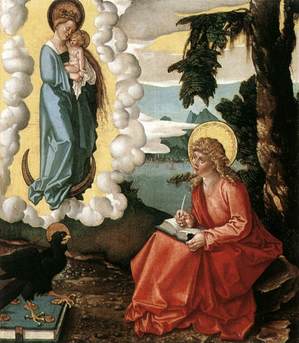This is John who reclined on the Lord’s breast at the Supper. O blessed Apostle, to whom were revealed heavenly secrets! (Magnificat antiphon)
The Roman Martyrology speaks of John in this way: “Sixty-eight years after the passion and death of His Lord, he died at a ripe old age. He was buried near Ephesus.” He was the lone of the 12 Apostles to die of natural causes, though he did suffer for Christ.
Perhaps no other of the Twelve than John has anyone been so close, so well-attuned to the Lord’s life, love and mission. To John was given the responsibility to mind Mary, the Mother of Jesus and thus to guide the Church in her in abiding in the Lord. It is not lost on us that the symbol of Saint John the Evangelist is the eagle who scales the heights and keenly aware of all things. In John’s case, he so sharply looks into reality and sees with profound depth the meaning of things.
About Saint John’s self-giving sacrifice we read:
Jesus loved him because the excellence of his chastity
made him worthy of the greatest love.
He was a virgin when chosen by the Lord,
and he remained virginal until death.
When near to death upon the Cross,
the commended His Virgin Mother
to John the virgin.
Very highly we must venerate blessed John;
for during the Last Supper he reclined
on the breast of the Lord.
And to his virginal care Christ entrusted His Virgin
Mother while on the Cross.
He, a virgin, was selected by the Lord
and loved more than the others.
(Pius Parsch, Year of Grace)
Important sacramental customs defines Catholic life outside the normal celebration of the sacred Liturgy (the Divine Office, Mass and the sacraments). It is a traditional custom to bless wine on the feat of Saint John the Evangelist. See the Blessing of Wine on the Feast of St. John, Apostle and Evangelist here.
